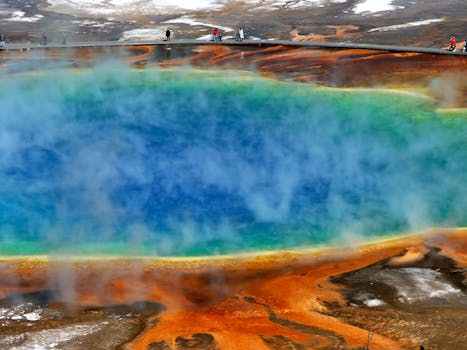Discover Yellowstone National Park: A Natural Wonderland
Yellowstone National Park, established in 1872, is not only the first national park in the United States but also the first in the world. Spanning over 3,400 square miles across Wyoming, Montana, and Idaho, it is renowned for its stunning geothermal features, diverse wildlife, and breathtaking landscapes. This article delves into the park’s geysers, hot springs, and wildlife, showcasing the natural wonders that make Yellowstone a must-visit destination.
The Geothermal Marvels of Yellowstone
Yellowstone is home to more than half of the world’s active geysers, making it a hotspot for geothermal activity. The park’s unique geology is a result of volcanic activity, which has shaped its landscape over thousands of years. Here are some of the most famous geysers:
- Old Faithful: Perhaps the most iconic geyser, Old Faithful erupts approximately every 90 minutes, shooting water up to 185 feet in the air. Its predictability draws thousands of visitors each year.
- Castle Geyser: Known for its impressive eruptions that can last up to 20 minutes, Castle Geyser is a favorite among photographers and nature enthusiasts.
- Grand Prismatic Spring: The largest hot spring in the United States, Grand Prismatic is famous for its vibrant colors, which are a result of microbial mats that thrive in its warm waters.
These geothermal features not only provide stunning visuals but also play a crucial role in the park’s ecosystem. The heat from the geysers and hot springs creates unique habitats for various organisms, contributing to the park’s biodiversity.
Hot Springs: Nature’s Colorful Pools
Hot springs are another significant feature of Yellowstone’s geothermal landscape. The park boasts over 10,000 hot springs, each with its own unique characteristics. The colors of these springs are often mesmerizing, ranging from deep blues to vibrant oranges and yellows. The coloration is primarily due to the presence of thermophilic bacteria that thrive in the extreme temperatures.
Some notable hot springs include:
- Morning Glory Pool: This spring is known for its brilliant blue color, which is a result of the clear water and the absence of microbial life at its depths.
- Black Sand Basin: This area features several hot springs and geysers, including the striking Emerald Pool, which showcases vivid green hues.
- Bechler Region: Often referred to as the “Cascade Corner,” this area is home to numerous hot springs and waterfalls, providing a more secluded experience for visitors.
Wildlife: A Diverse Ecosystem
Yellowstone is not just about geothermal wonders; it is also a sanctuary for a wide variety of wildlife. The park is home to over 60 species of mammals, including:
- Bison: Yellowstone hosts the largest free-roaming population of bison in the United States, with numbers reaching around 4,500.
- Grizzly Bears: These majestic creatures roam the park, and sightings are common, especially in the spring and early summer.
- Elk: The park is home to a significant population of elk, particularly in the northern regions, where they can often be seen grazing.
Birdwatchers will also find Yellowstone to be a paradise, with over 300 species of birds recorded in the park. The diverse habitats, ranging from forests to wetlands, support a rich avian population.
Conservation Efforts and Visitor Experience
As one of the most visited national parks in the United States, Yellowstone faces challenges related to conservation and visitor management. The National Park Service implements various strategies to protect the park’s natural resources while ensuring a positive experience for visitors. Some of these efforts include:
- Monitoring wildlife populations to maintain ecological balance.
- Restoring habitats affected by human activity.
- Educating visitors about Leave No Trace principles to minimize environmental impact.
Visitors can explore Yellowstone through a variety of activities, including hiking, camping, and guided tours. The park offers over 900 miles of trails, providing ample opportunities to experience its natural beauty up close.
Conclusion: A Journey into Nature’s Heart
Yellowstone National Park is a treasure trove of natural wonders, from its spectacular geysers and hot springs to its diverse wildlife. The park’s unique geothermal features and rich ecosystems make it a vital area for conservation and a breathtaking destination for visitors. Whether you’re witnessing an Old Faithful eruption or spotting a bison on the plains, Yellowstone offers an unforgettable experience that connects you with the beauty of nature. As we continue to explore and appreciate this remarkable park, it is essential to prioritize its preservation for future generations to enjoy.
